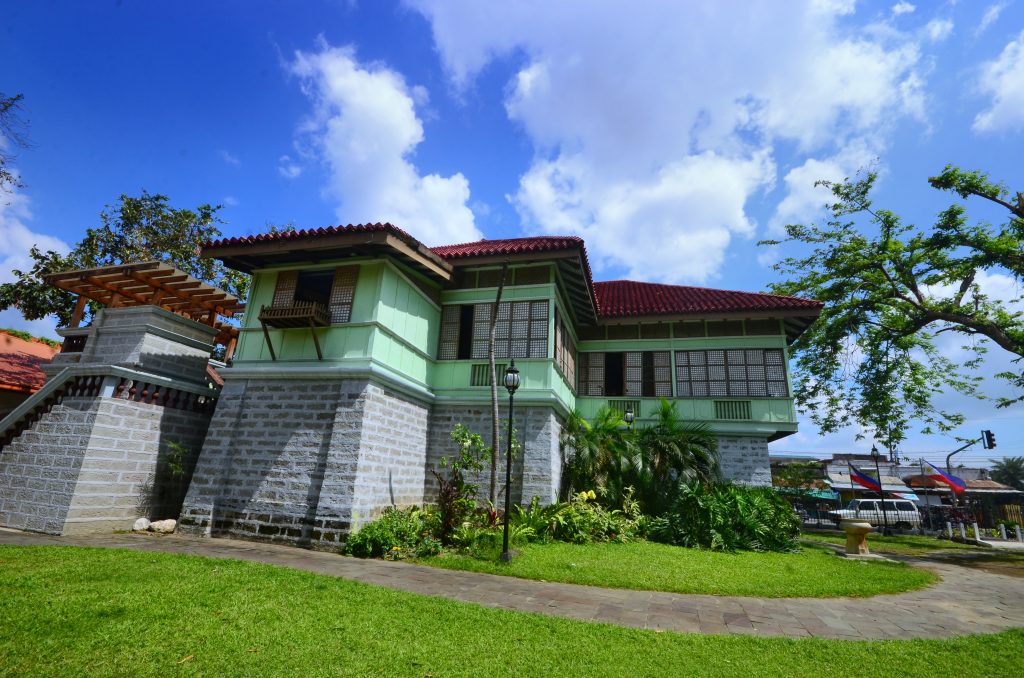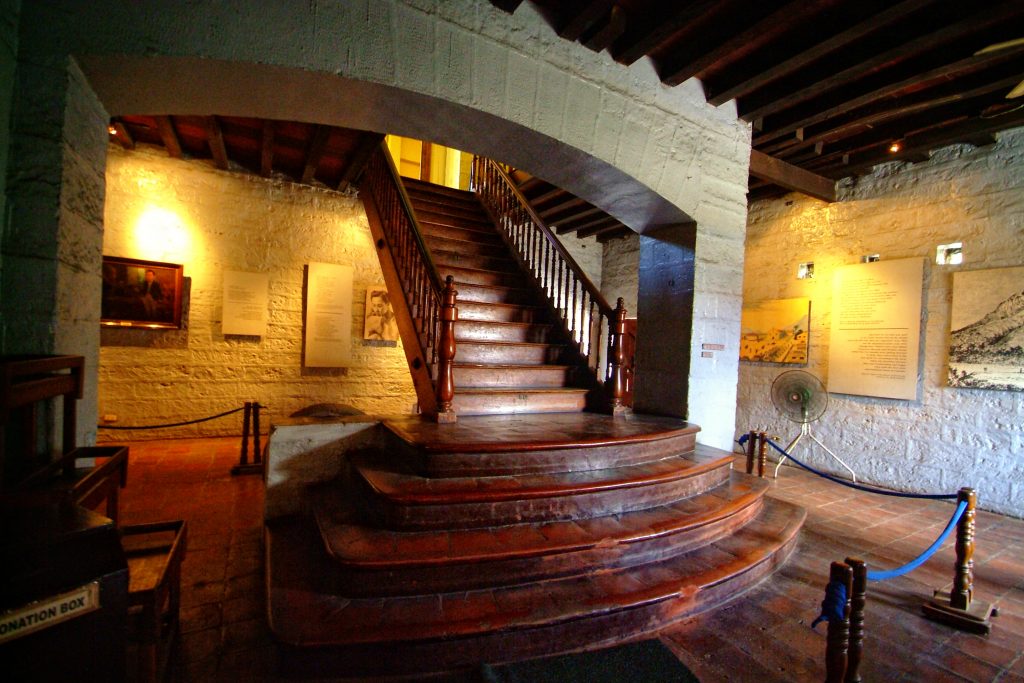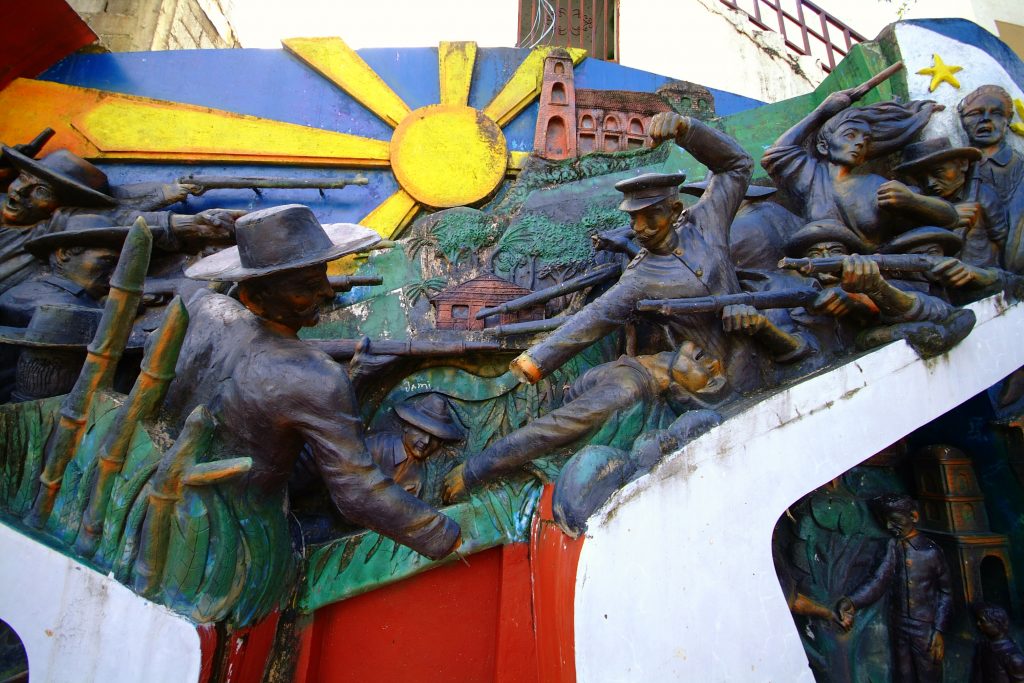Rizal Shrine (Museo ni Rizal) – Calamba City
A stone’s throw from Calamba’s town plaza and parish church stands the replica of the house where Jose Rizal was born on 19 June 1861. A two-storey stone and hardwood structure with narra floors, and red tile roof, the Rizal home has a spacious parlor with wide capiz shell windows, a library, dining room, three bedrooms, a kitchen and pantry leading out to a balcony. Located on the ground floor were the servants’ quarters, workroom, and a storeroom for food supplies. The backyard was planted with various fruit trees, which Rizal frequently mentioned in his writings: atis, santol, tampoy, makopa, plum, balimbing, and kasuy. A small nipa hut served as the young Jose’s hideaway.
The Museum contains a sizeable collection of Rizal’s memorabilia, a hologram of Rizal reading a letter addressed to his Austrian friend Dr. Ferdinand Blumentritt, and various interactive booths and terminals that offer information about Rizal and his time. Other facilities include an e-learning room for online history lessons.
Source: http://nhcp.gov.ph/museums/rizal-shrine-calamba/
Nagcarlan Underground Cemetery – Nagcarlan, Laguna
The Nagcarlan Underground Cemetery (Filipino: Libingan sa Ilalim ng Lupa ng Nagcarlan) is a national historical landmark and museum in Barangay Bambang, Nagcarlan, Laguna supervised by the National Historical Commission of the Philippines. It was built in 1845 under the supervision of Franciscan priest, Fr. Vicente Velloc as a public burial site and its underground crypt exclusively for Spanish friars, prominent town citizens and members of elite Catholic families It is dubbed as the only underground cemetery in the country.
Source: https://en.wikipedia.org/wiki/Nagcarlan_Underground_Cemetery
Calamba Claypot
CALAMBANGA, also known as the Calamba Jar or Calamba Claypot, is a famous landmark in Calamba, Laguna, Philippines believed to be the largest claypot in the world.[1] It is located at the City Plaza near Calamba Church and Rizal Shrine. Built in 1937, it is constructed to illustrate and immortalize the folk tale on how the city got its name[2] with the names of the city’s barangays inscribed on its surface.[3] The giant claypot can also be found in the city’s official seal.
Source: https://en.wikipedia.org/wiki/Calamba_Claypot
Japanese Memorial Garden – Cavinti
The Japanese Memorial Garden is located in the town of Cavinti, Laguna, along the shore of Lake Caliraya. The garden was established in 1970’s by the government in partnership with Japan to commemorate the fallen Japanese soldiers of World War II. Laguna bore witness in the twilight days of World War II. Mt. Kalisungan in Victoria, Laguna served as one of the last bastions of the Japanese guerillas.
Source: http://pearliantravels.blogspot.com/2019/03/japanese-memorial-garden-quick-getaway.html
Don Porong Ancestral Home – Pagsanjan
Don Porong Ejercito Mansion, located in Pagsanjan, Laguna, was built by Dr. Telesforo Vasquez Ejercito and Doña Lucina Abella Liza.
The Battle of Mabitac Mural – Mabitac
The Battle of Mabitac (Filipino: Labanan sa Mabitac, Spanish: Batalla de Mabitac) was an engagement in the Philippine–American War, when on September 17, 1900, Filipinos under General Juan Cailles defeated an American force commanded by Colonel Benjamin F. Cheatham, Jr. The mural is built to remember the Battle of Mabitac that took place back in 1900.
Source: https://en.wikipedia.org/wiki/Battle_of_Mabitac, http://www.biyahenglaguna.com/adventures/throwback-adventure/battle-mabitac-mural/
Nagcarlan Underground Cemetery – Nagcarlan
The Nagcarlan Underground Cemetery (Filipino: Libingan sa Ilalim ng Lupa ng Nagcarlan) is a national historical landmark and museum in Barangay Bambang, Nagcarlan, Laguna supervised by the National Historical Commission of the Philippines. It was built in 1845 under the supervision of Franciscan priest, Fr. Vicente Velloc as a public burial site and its underground crypt exclusively for Spanish friars, prominent town citizens and members of elite Catholic families. It is dubbed as the only underground cemetery in the country.
Source: https://en.wikipedia.org/wiki/Nagcarlan_Underground_Cemetery
Puerta Real – Pagsanjan
Pagsanjan Arch also known as Puerto Real or Arco Real is a historic town gate of Pagsanjan, Laguna built from 1878 to 1880 under the supervision of Fray Cipriano Bac. The arch was built by the people of Pagsanjan to express gratitude to their patroness, the Our Lady of Guadalupe, from protecting the town from bandits in 1877. The arch is located at the western entrance of the town along the National Highway. It leads to Rizal Street (formerly Calle Real) of the town.
Source: https://en.wikipedia.org/wiki/Pagsanjan_Arch
Heritage Town – Pila
The town of Pila successfully preserved its Spanish colonial heritage, the town center is a living example of Spanish colonial town planning and development; its church-plaza-municipal hall complex forms the heart of the Noble de Pila. The structures of Pila reflect a rich and varied architectural history, which remains relatively intact in its town center, from the Philippines-Baroque church of the Spanish period to the charming chalets of the American period. The town of Pila is a living monument and testimony to the residents of Pila who were the builders, craftsmen, artist and artisans of such elegant, historic structures. The Pila Museum situated near the church houses the collections of important artifacts from Pila dating to Spanish time. Displayed also are clay pots which were discovered in an excavations made at Pinagbayanan in 1967.
The Emilio Jacinto Shrine
The Emilio Jacinto Shrine is located in San Juan, Sta. Cruz Laguna and can be access freely. It is built as a tribute to General Emilio Jacinto that symbolizes his bravery.




